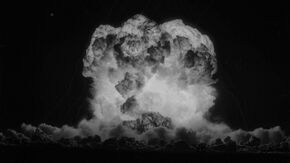Ace (nuclear test)
| Nuclear weapons testing Dytika | |
|---|---|
 Mushroom cloud of Dytika after detonation | |
| Information | |
| Country | |
| Test site | Jürsand |
| Date | March 5, 1949 (70 years ago) |
| Test type | Atmospheric |
| Device type | Uranium implosion fission reaction |
| Yield | 27 kilotons of TNT (~118 TJ) |
| Test chronology | |
Dytika was the first detonation of a nuclear weapon conducted by the Crowned Republic of Mascylla on the island of Jürsand at 12:00 a.m. on March 5, 1949, as part of one of the Great Game's arms races between Mascylla and Hytekojuznia. The testing site was the desolate and uninhabited Jürsand island about 110 kilometres (68 miles) east of Ankstedt, situated in what was then the CRN Jürsand-Kappe Marine Testing and Proving Territory. For the purposes of the test, the Jürsand Vicinity Site and three other buildings were built in the vicinity of the blast zone to observe effects of the detonation on the structures and to use them as laboratories for nuclear weapon components.
The test was of an implosion fission reaction uranium device, which was informally nicknamed Ace. The complexity of the design required the efforts of the entire Reichswehr, and concerns about whether it would work led to a decision to conduct the nuclear test afterall. However, the success of the test had foremost priority as Hytekojuznia had already developed a functional nuclear weapon in 1948, and Mascylla's security was regarded endangered by this new technology. The project was overseen by Gerhard Wayner and Prime Minister Ernest Rähner, and the test was principalised and directed by Reinhardt Schmiede.
Dytika released the explosion yield of about 27 kilotons of TNT, exceeding the predicted 22 kilotons, due to unforeseen additional reactions and highly enriched uranium being used. At the time of its detonation, it was the largest artificially generated explosion in history.